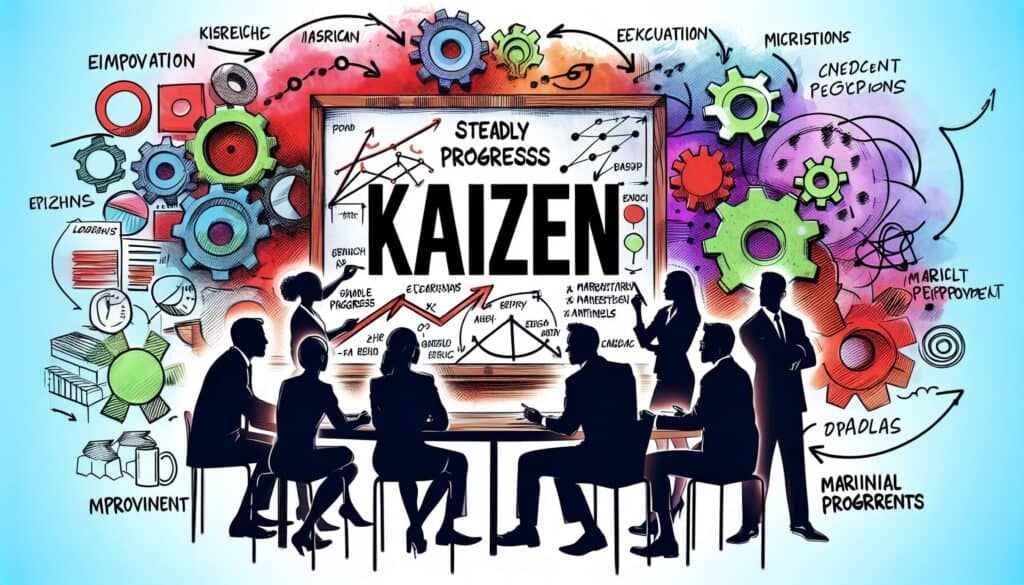A philosophy and practice of making ongoing, incremental improvements to processes, products, and services, involving everyone in an organization.
- 方法: 工程, 质量
改善(持续改进)

改善(持续改进)
- 持续改进, 改善, 精益制造, 计划-实施-检查-行动(PDCA), 流程改进, 工艺优化, 质量保证, 质量管理
目标
如何使用
- Involves regular, small-scale improvement activities (e.g., Kaizen events or Blitzes, suggestion systems) where teams identify waste or inefficiencies, brainstorm solutions, implement changes, and standardize successful improvements. Focuses on PDCA cycles.
优点
- Promotes a culture of continuous learning and employee engagement; Leads to gradual but significant long-term improvements; Low cost, often focusing on creativity over capital investment; Improves efficiency and reduces waste.
缺点
- Requires strong management commitment and supportive culture; Can be slow to achieve radical changes if only small steps are taken; Sustaining momentum can be challenging; May faceresistance from employees accustomed to traditional ways.
类别
- 构思, 精益西格玛, 制造业, 解决问题, 项目管理, 质量
最适合:
- Fostering a culture of ongoing, incremental improvements across all aspects of an organization to enhance quality, efficiency, and employee satisfaction.
Kaizen is frequently applied across various industries including manufacturing, healthcare, and service sectors, where continuous improvement can significantly enhance operational effectiveness. During the development phase of a product, teams can initiate Kaizen events or Blitzes, bringing together cross-functional groups to identify specific areas of waste or inefficiency within processes. For instance, in a manufacturing setting, Kaizen might focus on optimizing assembly line procedures through small adjustments that minimize downtime or eliminate redundant steps. Healthcare facilities often employ Kaizen to improve patient flow and resource allocation, allowing staff to devise solutions that enhance care delivery without necessitating substantial budget increases. Participating team members may include engineers, quality control experts, frontline staff, and management, all of whom contribute their unique perspectives and expertise to the problem-solving process. The use of PDCA (Plan-Do-Check-Act) cycles enables teams to systematically implement improvements, monitor the impact, and standardize successful changes. These methodologies can lead to a culture where employees feel empowered to suggest ongoing refinements, ultimately engendering a sense of ownership and commitment to achieving excellence within the organization. As improvements accumulate over time, the results can transform operational capabilities, increase customer satisfaction, and promote a sustainable environment where continuous learning becomes integral to the organization’s ethos.
该方法的关键步骤
- Identify areas of improvement through collaboration and observation.
- Brainstorm potential solutions for identified inefficiencies.
- Implement selected improvements on a small scale or in pilot tests.
- Standardize successful changes to ensure consistent application.
- Review the effects of implemented changes and gather feedback.
- Repeat the cycle to continuously seek further enhancements.
专业提示
- Incorporate cross-functional teams in Kaizen events to leverage diverse perspectives and enhance problem-solving capabilities.
- Use data analytics to identify specific areas of waste and inform decision-making during improvement initiatives.
- Establish a robust feedback loop post-implementation to evaluate the long-term impact of changes and continually refine processes.
历史背景
1950
1980
1980
1986
1994
1995
2000
1960
1980
1983
1990
1995
2000
2010
(如果日期不详或不相关,例如 "流体力学",则对其显著出现的时间作了四舍五入的估计)。














相关文章
METS 卡路里计算器
元分析
信息映射
心理模型图
可接受的最大推力和拉力
物料需求计划(MRP)